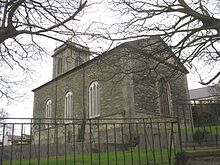St Eleth's Church, Amlwch
| St Eleth's Church, Amlwch | |
|---|---|

St Eleth's Church from the south-east
|
|
| Coordinates: 53°24′36″N 4°20′43″W / 53.410074°N 4.345189°W | |
| OS grid reference | SH 441 929 |
| Location | Amlwch, Anglesey |
| Country | Wales, United Kingdom |
| Denomination | Church in Wales |
| History | |
| Founded | 6th century (reputedly) |
| Founder(s) | St Eleth (reputedly) |
| Dedication | St Eleth |
| Consecrated | 1800 (current building) |
| Architecture | |
| Status | Church |
| Functional status | Active |
| Heritage designation | Grade II* |
| Designated | 25 October 1951 |
| Architect(s) | James Wyatt |
| Style | Neo-classical |
| Construction cost | £2,500 to £4,000 (c. £182,000 to £291,300 in present-day terms) |
| Specifications | |
| Materials | Rubble masonry with ashlar dressing |
| Administration | |
| Parish | Amlwch |
| Deanery | Twrcelyn |
| Archdeaconry | Bangor |
| Diocese | Diocese of Bangor |
| Province | Province of Wales |
| Clergy | |
| Priest in charge | H. V. Jones |
St Eleth's Church, Amlwch is a parish church built in the Neo-classical style in 1800 in Amlwch, a town on the island of Anglesey in north Wales. It stands on the site of earlier buildings, with the first church here said to have been established by St Elaeth (or Eleth) in the 6th century. Increasing prosperity in the town through copper mining during the 18th century led to the construction of a new church to serve the growing population.
The church is still used for services within the Church in Wales, and is one of four churches in the parish of Amlwch. It is a Grade II* listed building, a designation given to "particularly important buildings of more than special interest", because it is a "substantially Neo-classical church retaining much of its original architectural character".
The first church in the area was reputedly established in the 6th century by Elaeth, or Eleth. He was a ruler from northern Britain who fled to Anglesey in north Wales when ousted from power, settling at St Seiriol's monastery at Penmon.
Amlwch grew and became increasingly prosperous during the 18th century after copper mining began at nearby Parys Mountain in 1768. As a result, the church became too small. Planning for a replacement church began in 1787 when Thomas Williams, "the Copper King", offered £600 (approximately £68,800 in present-day terms). The Copper Mines Company provided the majority of the money required for the new church; Henry Paget, 1st Earl of Uxbridge, and the Reverend Edward Hughes (a co-owner of the mines) also made donations. Work eventually got underway and the church, designed by the architect James Wyatt, was built and consecrated in 1800. Different figures for the cost of construction are given by two 19th-century writers: in 1833, Angharad Llwyd said that the cost was £4,000 (approximately £291,300 in present-day terms) but in 1849, Samuel Lewis stated it to have been £2,500 (approximately £182,000 in present-day terms).
...
Wikipedia

